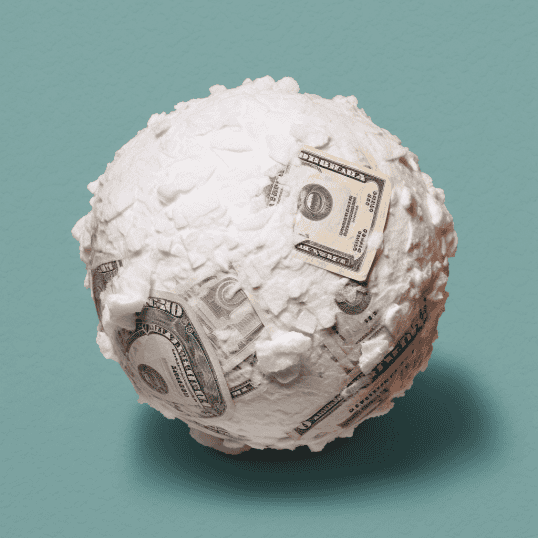It’s essential to have a debt paydown plan when looking to improve your personal finances or pursue financial independence. By aligning your strategies to your financial motivations and spending a little bit of time reviewing each month, you can build a plan to get out of debt and work on building an engine that will create wealth for your family. This post focuses on the crucial steps to building winning strategies to prioritize and eliminate your debt, one line item at a time! It will also help you with the decision of whether to invest or pay down debt with any extra savings.
Understand and make a list of all your debt
First, start by organizing and sorting all your debts by amount and type. You’ll want a breakdown of all of your debts + the total amount you owe, and the yearly percentage of that debt. Here is an example of what that may look like for someone with a mortgage, student loans, car payments, credit cards, margin interest for investing (not recommended), and a buy now pay later installment.
| Debt | Amount | APR% |
|---|---|---|
| Mortgage | $400,000 | 4.50% |
| Student loans | $125,000 | 6.00% |
| Credit Cards | $10,000 | 25.00% |
| Car Loan | $15,000 | 4.00% |
| Margin Investment Loan | $5,000 | 7.00% |
| Buy Now Pay Later | $800 | 3.00% |
Next, determine the percentage of the total and blended APR rate of your debt. Start by calculating the percentage of your debt each line item makes against your total. Divide each line amount by the SUM of all your debt (including the line you are using. For the example mortgage, the equation looks like % debt = ($400,000/$555,800)*100 = 72.07%.
Repeat for each line item.

As a sanity/double math check, your overall percentage of debts should sum to 100.
Next, multiply the APR% by the percentage of overall debt and SUM all these values together to get your blended/weighted APR%. This shows you exactly how much interest you are paying on average across all your sources of debt.
For this example, the blended APR is 5.22%
Debt Snowball VS Debt Avalanche


The debt snowball VS Debt avalanche methods has long been debated. There are merits to both strategies and ultimately, both will help you pay down your debts over time. Let’s explore both methodologies and the thought process behind them.
The debt snowball method is an approach that prioritizes paying off your smaller debts in full before moving to larger debts.
You secure the psychological wins of watching your debts get wiped out by smallest to largest and can feel the progress you are making. Minimum payments for debt sources that are eliminated are freed up in your cash flows and you are able to put those savings toward paying off larger debts. With this method, we would start by paying off the Buy Now Pay Later loans in our example debt and then moving up the list by size of the debt. Here’s the pay-down order with the debt snowball:
| Debt pay order | Amount | APR |
|---|---|---|
| Buy Now Pay Later | $800 | 3.00% |
| Margin Investment Loan | $5,000 | 7.00% |
| Credit Cards | $10,000 | 25.00% |
| Car Loan | $15,000 | 4.00% |
| Student loans | $125,000 | 6.00% |
| Mortgage | $400,000 | 4.50% |
With the debt avalanche method, we want to minimize the overall interest paid. Outside of the minimum payments for each loan, this means always choosing to pay off the loans with the highest APR% and moving down the list with any extra money we have for debt repayment. This strategy lacks the psychological wins of the debt snowball strategy but is the optimal way to do things since you pay less interest over time. Here is how the debt would be repaid with the debt avalanche strategy:
| Debt pay order | Amount | APR |
|---|---|---|
| Credit Cards | $10,000 | 25.00% |
| Margin Investment Loan | $5,000 | 7.00% |
| Student loans | $125,000 | 6.00% |
| Mortgage | $400,000 | 4.50% |
| Car Loan | $15,000 | 4.00% |
| Buy Now Pay Later | $800 | 3.00% |
There are merits to both strategies, but ultimately, the Debt avalanche is the most optimal way to repay debt as it minimizes the interest that you must pay. If you can improve your debt situation without the psychological wins and ‘feeling’ of progress granted by the snowball method, this strategy is a clear winner.
👋Tip: Using a personal finance tracker like Mint or Empower can give you a great tool to visualize and track all your debt. You can see how your loans have decreased or increased over time and quantifiably track your progress.
Paying off extra debt VS investing the money instead
The decision to pay off extra debt VS invest is highly personal and there are a lot of variables at play that may affect your decision. It depends on your future outlook, risk tolerance, how having the debt makes you feel, your investment outlook, and much more.
I’m a huge fan of Sam Dogen’s Financial Samurai blog. Sam introduced a ratio that has been extremely helpful in building my own framework for debt repayment–FS DAIR. I highly recommend reading the full article, but the general formula is to take your highest APR debt’s interest rate and multiply it by 10. This is the percentage of extra money to allocate toward paying down debt VS investing.
Any debt at or above 10% means that you should be putting 100% of your extra money toward debt repayment and not making additional post-tax investments. This is a fine strategy and ratio, and a calculation I do in my head almost every month when choosing to pay off extra mortgage debt, work on building my emergency savings fund and cash reserve or invest in my brokerage account.
I like to look beyond the FS DAIR and look at returns across various risk assets and risk-free assets like treasury bonds and CDs. How do they compare to the roughly 8% annualized return I could expect from a total market index fund? How do they compare to my mortgage’s interest rate?
My mortgage has a 4.625% interest rate. With the FS DAIR ratio, the calculation shows that I should allocate 46.25% of extra savings toward paying off my mortgage, and the other 53.75% toward making new investments. Right now, I’m paying an extra 10% of my monthly savings on my mortgage payment in principal. Much less than the 46.25% from FS DAIR.
Mortgage debt (good) is much different than credit card debt (bad). For one, every extra dollar you put into paying off your loan principal on your mortgage becomes $1 of equity. When you repay the credit card company, you are not building equity. While it is hard to live off the value of your primary residence, real estate equity does factor into your net worth calculation and $1 of equity can appreciate whereas $1 of extra credit card payments reduces what you owe.
Since credit card debt almost always has an insane APR, it’s ideal to eliminate all credit card debt as soon as possible and to avoid carrying a balance going forward.
One important thing to consider when paying down extra debt toward a mortgage and building equity is the fact that any extra principal paid is forced savings and becomes locked into the home. Unless you have an existing HELOC or plan on selling/refinancing any time soon, that money becomes highly illiquid. Having an interest rate that is less than current market rates or the risk-free rate of return also makes it much less compelling to pay off extra mortgage principal.
I can open new short-term CDs (risk-free) yielding 5.35-5.40% at the time of writing that offer much greater liquidity than money put toward paying off my mortgage early. The flexibility of this cash offers greater opportunities and adaptability in the future and helps shelter against economic hardship. For now, I’m much more incentivized to keep my relatively low-interest rate on the mortgage (compared to today’s rates) and pursue other investment opportunities instead.
Why paying off your debt may provide a higher return than face APR value
Paying off debt may provide a higher return than you may initially think if you are taking the standard deduction on your tax return AND your all-up eligible write-offs should you itemize them total less than the standard deduction.
For example, since my mortgage has a 4.625% APR, every dollar I put into paying down the principal should return 4.625% a year. But if I’m taking the standard deduction and know my total write-offs are less than that amount, every extra dollar I put into my principal earns between 15-24% additional return on the base since I’m not paying taxes on it.
My tax bracket puts me at 15% taxes for long-term capital gains and qualified dividends, and 24% for every dollar of additional ordinary income/unqualified dividends/short-term capital gains.
Here’s the math:
$100 of additional principal paid toward my mortgage = $4.625 of interest payments saved.
4.625% return on a $100 investment via qualified dividends/long-term capital gains (15% tax) = $3.93 of income after taxes.
4.625% return on a $100 investment via unqualified dividends/short-term capital gains/interest income (24% tax) = $3.52 of income after taxes.
To match the true return of paying down extra mortgage principal, I’d need a higher return on investment.
To match the interest pay down of my 4.625% mortgage via qualified dividends/long-term capital gains I’d need a 5.32% return.
To match the interest pay down of my 4.625% mortgage via unqualified dividends/short-term capital gains I’d need a 5.74% return.
With some exceptions, when itemizing your deductions including interest expense, $1 of extra debt paydown will have a real face value return of its APR. Since I will be itemizing this year, I only need to consider the face value of the APR (4.625%) when deciding to pay down the extra principal or invest the money instead.
Why consider paying down extra debt even though it may not be financially ‘optimal’
- Debt repayment is a fixed cost. There is value in repaying debt simply to eliminate a source of additional fixed cost in your budget to free up cash flow for more flexibility elsewhere. You may need or value this flexibility in ways that are difficult to quantify.
- Debt is emotional. If you know you will be happier/more secure & less stressed by paying off your debts, that needs to be factored into the equation. If you sleep better at night paying off debt, there is immense value in that alone.
- You have a lower risk tolerance and want a guaranteed return. You will always make your APR% (or higher as illustrated above) as a guaranteed return for every $1 extra you put toward paying down your debt. Paying down debt can hedge against potential market losses.
- It almost never feels ‘bad’ to pay off extra debt. The less bad debt you have, the easier it will be to improve your finances.
💬What strategies do you use to repay debt? How do you choose to invest or pay down extra debt? Have any questions or comments? Join the discussion in the comments sections below!








Comments